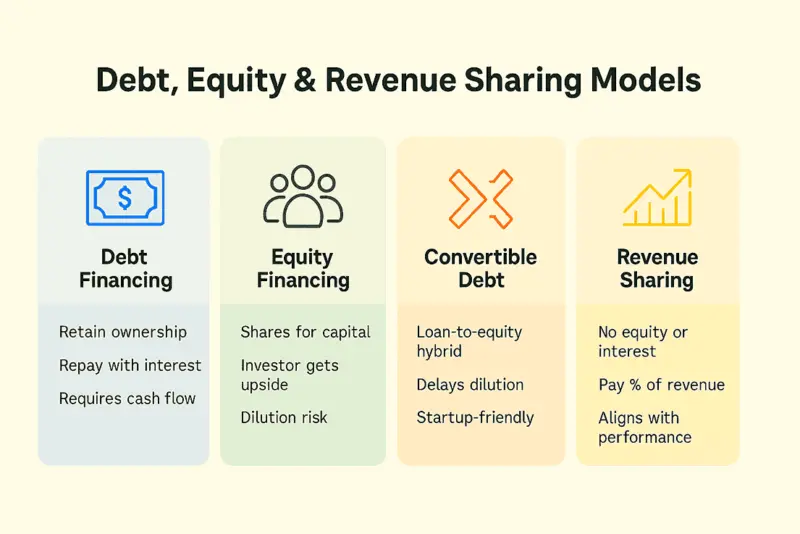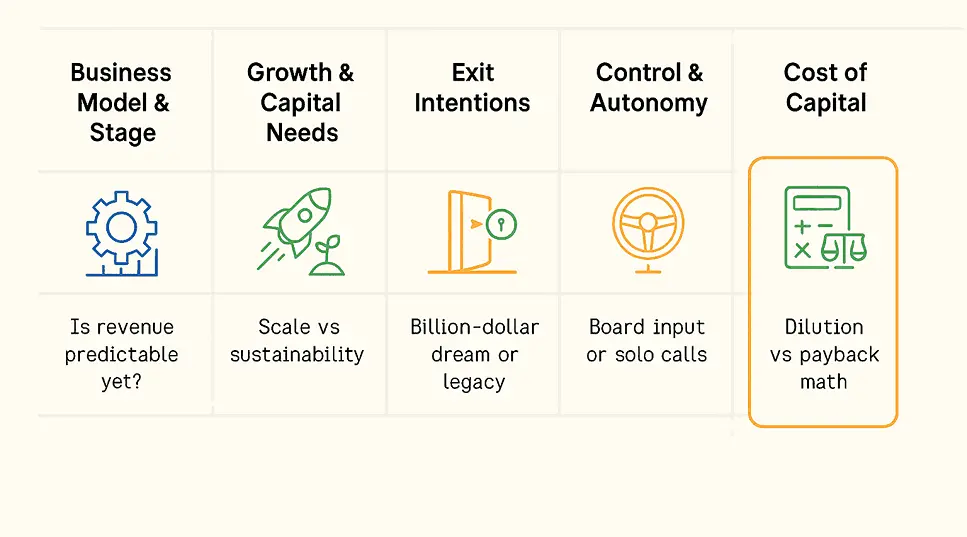The scale of startup financing has grown. The average Series C round in 2024 reached $50 million. This highlights how pivotal choosing a capital strategy is as companies raise higher sums. Founders must align funding types to maximize these opportunities.
Equity financing and revenue sharing represent two distinct paths, each with unique benefits and challenges. While equity financing involves selling ownership stakes in exchange for capital, revenue sharing ties repayments to a percentage of your company’s earnings. Understanding these models is essential for aligning your financial strategy with your business goals.
Let’s explore how these funding approaches differ and how to choose the one that best suits your needs.
Your Quick Guide to Debt, Equity, and Revenue Sharing Models
Funding decisions often shape the trajectory of a business. Debt financing means borrowing funds with an obligation to repay, often with added interest. Choosing between equity and revenue share depends on your growth goals and desire for control.
- Are you willing to give up ownership?
- Is predictable cash flow present?
- Is rapid growth needed?
Use these questions to guide your funding choice.

Convertible debt is a loan that can become company stock under specific conditions. It bridges the gap between debt and equity models. This hybrid structure is popular among startups for initial funding. It avoids immediate equity dilution.
Revenue sharing introduces a fresh perspective. Instead of repaying loans or giving up equity, businesses share a percentage of their revenue with investors until a predetermined amount is reached. This model aligns investor returns with business performance, making it an attractive option for companies with steady revenue streams.
For a broader perspective on financing options, a review of the various types of startup funding expands your understanding of capital-raising methods, laying the groundwork for comparing models like equity and revenue share.
Equity vs Revenue Share: What You Need to Know
Choosing between Equity vs Revenue Share models can significantly impact your business’s future funding strategy.
Equity Financing: Selling Ownership for Capital
Equity financing means raising money by selling pieces of your company to investors. You get capital to grow, often faster than bootstrapping, but your ownership stake shrinks with each round. For founders, this trade can be powerful when long-term growth needs heavy upfront investment, but it also brings reduced control and the possibility that investor priorities won’t always match your own.
Equity isn’t just “shares for cash”; it comes with tax and legal consequences. Different types of equity offers, like ISOs vs. NSOs, carry different tax treatments and Alternative Minimum Tax (AMT) risk, and NSOs can trigger withholding while ISOs may qualify for capital-gains treatment if held long enough.
Poorly structured or badly documented equity can be brutal: industry attorneys report that over 60% of startup founders end up in court over equity issues, and founders who give up more than half the company effectively become minority owners in their own startup.
The takeaway: equity financing can be a powerful growth engine, but every grant, round, and clause in your agreements matters. Treat equity terms, tax implications, and control carefully now, or you’ll pay for it later, in ownership, in court, or both.
Revenue Sharing: Performance-Based Repayments
Revenue sharing is an alternative to equity financing that lets you raise capital without giving up ownership. Instead of selling shares, you agree to pay investors a fixed multiple of their investment—typically 1.5x to 2.5x—using a percentage of your future revenue until that target is reached. Because repayments rise and fall with your actual revenue, this model is more flexible than fixed loan payments and can be less stressful during slower months.
The global revenue-based financing (RBF) market is growing fast, projected to increase from about $4.20 billion in 2024 to $14.50 billion by 2034 at a CAGR of roughly 13.2%. That momentum reflects how attractive performance-based capital has become for startups that want funding without immediate dilution.
Alongside RBF, you can also consider bootstrapping, funding growth from your own cash flow, which avoids both debt obligations and equity loss entirely, as long as your business model can support it.
You can also look for options like bootstrapping, which highlight self-funding as a viable way to bypass debt or equity obligations entirely.
Key Differences and Considerations
Both equity financing and revenue sharing have their merits, but the choice depends on your business goals and priorities.
- Ownership and Control: Equity financing dilutes ownership, potentially impacting decision-making power. Revenue sharing, on the other hand, preserves ownership and control, allowing founders to maintain their vision.
- Repayment Structure: Equity financing does not require direct repayments, as investors earn returns through company growth or eventual exit. Revenue sharing involves performance-based repayments, ensuring investors are compensated as the business generates revenue.
- Investor Alignment: Revenue sharing aligns investor goals with business performance, fostering a collaborative relationship. Equity financing may lead to differing priorities between founders and investors.
For a deeper understanding of how revenue-based financing works, explore our comprehensive guide on revenue-based financing explained.
Equity vs Revenue Share: Ownership, Finances, and Growth Compared
Understanding Equity vs Revenue Share helps founders evaluate the trade-offs between funding models for their startup. Choosing between Equity vs Revenue Share involves balancing ownership control, financial commitments, and growth potential.
Equity Financing: Ownership vs. Growth
Equity financing gives startups access to substantial capital by trading a portion of ownership to investors. For companies aiming for rapid growth, this can be a powerful option, capital often comes bundled with strategic guidance, hiring support, and valuable industry connections. The trade-off is dilution and the reality that investors will have a say in key decisions, so founders need to be very clear about how much control they’re willing to share.
To decide whether equity is being used wisely, you need to measure capital efficiency, not just how much you’ve raised. Current benchmarks show Series A SaaS companies now sit at a median burn multiple of around 1.6×, meaning they burn $1.60 to add $1 in new ARR.
In contrast, Notion reportedly achieved a burn multiple near 1.0× in 2023, effectively turning each $1 burned into $1 of new ARR. That kind of discipline shows what’s possible when growth and efficiency are managed together instead of treated as opposites.
Investor relations sit at the center of this equation. When you raise equity, you’re not just getting money, you’re entering a long-term partnership. Building trust, communicating transparently, and sharing clear plans for how capital will be deployed make it much easier to maintain support through both good and bad quarters. Done right, equity financing becomes a tool to amplify your growth, not just a faster way to give pieces of the company away.
Debt Financing: Retaining Control with Financial Obligations
Debt financing allows founders to retain full ownership while borrowing funds to fuel growth. This model is ideal for businesses with predictable revenue streams and a clear repayment plan. However, the financial obligations, including interest payments, can strain cash flow, especially during economic downturns.
Unlike equity financing, debt does not involve sharing decision-making power, but it requires careful management to avoid over-leveraging. Founders must assess their ability to meet repayment terms without compromising operational efficiency.
Investor Involvement and Founder Control Comparison
Revenue Share Models: Flexibility and Simplicity
Revenue share financing is gaining traction as a flexible alternative to traditional funding. Investors increasingly favor financing models aligning returns directly with revenue streams, as highlighted in the Revenue Focus shift. This approach ties repayments to actual sales, reducing pressure during slower periods.
For founders, revenue share models offer simplicity and preserve ownership, making them an attractive option for businesses with fluctuating income. However, the trade-off lies in sharing a portion of revenue, which could impact profitability during high-growth phases.
Emerging Trends: Hybrid Financing Models
Innovative funding structures are reshaping the landscape. Hybrid financing models, which combine revenue-based instruments with small equity portions or convertible debt, are becoming popular among startups seeking balanced solutions. These models provide flexibility while addressing the limitations of traditional financing options.
Additionally, there is a growing Shift to Non-Dilutive Financing, as founders opt for alternative structures that preserve ownership. These trends reflect evolving preferences and the need for adaptable strategies in a competitive market.
Practical Considerations for Decision-Making
When evaluating funding models, startups must prioritize simplicity and manageability. Understanding the implications of each option on ownership, financial health, and growth potential is crucial. Founders should also consider investor expectations and align their funding strategy with long-term goals.
Legal and Tax Complexities in Funding Agreements
Building on practical decision-making, founders should address legal and tax complexities when structuring equity or revenue share agreements. These factors influence contract terms, compliance obligations, and long-term financial outcomes. Engaging legal and accounting professionals early helps clarify entitlements, repayment terms, and tax liabilities. Proactive planning ensures funding agreements support business growth while minimizing regulatory risks.
Best Practices for Negotiating Funding Contracts
- Clearly define revenue percentages, payment duration, and exit triggers in all funding agreements to avoid future disputes.
- Include specific eligibility criteria and performance benchmarks for sweat equity or profit sharing to align incentives with business goals.
- Consult legal and tax professionals to ensure contracts comply with regulations and minimize unexpected liabilities for all parties involved.
Is Equity Financing Right for Your Industry?
Equity financing often serves as a lifeline for industries that demand substantial upfront capital and well-defined exit strategies. This approach is particularly advantageous for sectors like technology and high-growth industries, where innovation and rapid market expansion are critical.
Industries That Thrive on Equity Financing
Technology Startups
Tech startups frequently rely on equity financing to fuel their growth. For example, early-stage technology ventures often depend on equity inflows to accelerate product innovation. A case in point is an unnamed SaaS company that utilized equity financing to secure significant funds for research and development. This enabled swift market capture, despite the potential dilution of ownership.High-Growth Sectors
Industries experiencing rapid growth, such as renewable energy or biotech, often benefit from equity financing. These sectors require substantial capital to scale operations and meet market demands. Equity financing provides the flexibility to focus on long-term growth without the immediate repayment pressures associated with debt financing
Alternative Options for Smaller Capital Needs
For businesses that don’t require large-scale funding, microloans can be a practical alternative. A study of microloans for startups reveals how smaller-scale lending options can offer accessible financing during the early stages of business development.
Equity financing is not a one-size-fits-all solution, but for industries where innovation and scalability are paramount, it can be the key to unlocking growth potential.
How Revenue Share Financing Works Across Industries
For SaaS companies and recurring revenue models, efficiency and adaptability are vital for growth. In 2025, median revenue per employee reached $129,724, rising from $125,000 in the previous year. This steady growth highlights how performance-tied financing can support operational scalability across industries.
Revenue share financing offers a flexible approach to funding that aligns repayment with business performance, making it an attractive option for companies across diverse sectors. This model is particularly suited to industries that prioritize sustainable growth and customer engagement, as it provides access to capital without sacrificing long-term ownership.
Applications Across Different Business Types
Main Street Businesses
Small businesses, such as family-owned retail chains, often face challenges in securing traditional loans without risking ownership. Revenue share financing allows these businesses to expand while maintaining control. For instance, a family-owned retail business successfully used this model to fund location expansions, tying repayments directly to store revenue. This approach ensures that repayment scales with actual sales, reducing financial strain during slower periods.Lifestyle Ventures
Entrepreneurs running lifestyle businesses benefit from the adaptability of revenue share financing. Since repayment is tied to revenue, these ventures can focus on customer engagement and steady growth without the pressure of fixed monthly payments. This flexibility supports businesses that aim to balance profitability with personal fulfillment.Social Impact Enterprises
Social impact organizations often prioritize community-focused goals over rapid profit generation. Revenue share financing aligns well with these objectives, enabling access to capital while preserving mission-driven ownership. By linking repayments to revenue, these enterprises can reinvest in their initiatives without compromising their long-term vision.
Why Revenue Share Financing Stands Out
This funding model is ideal for businesses seeking sustainable growth without diluting ownership. It empowers companies to scale operations while maintaining control, making it a preferred choice for industries that value flexibility and customer-centric strategies.
Essential Terms for Revenue Share Agreements
- Clearly define what constitutes revenue in the agreement to prevent future disputes and ensure transparent calculations.
- Specify payment frequency, percentage, and repayment cap to align expectations and manage cash flow effectively.
- Include provisions for early repayment, default scenarios, and dispute resolution to protect both parties’ interests.
- Outline reporting requirements and audit rights so investors can verify revenue figures without disrupting operations.
- Consult legal and tax professionals before signing to address compliance, liabilities, and potential tax implications.
To explore additional creative financing methods that complement traditional capital strategies, check out our guide on alternative funding for startups.
Key Factors in Choosing the Right Model

1. Business Model and Stage
Your business model is perhaps the most important factor in this decision. Software-as-a-service companies with recurring revenue, e-commerce businesses, and service companies with predictable cash flow are excellent candidates for revenue share. The model is less suitable for hardware companies, biotech startups, or businesses with long development cycles before generating revenue.
Early-stage, pre-revenue companies have no choice but to pursue equity financing. Revenue share becomes viable once you have consistent monthly revenues, typically at least $50,000 to $100,000.
2. Growth Trajectory and Capital Needs
If you're building a company that requires massive scale to succeed, with winner-take-all market dynamics, equity financing is typically the better choice. Think of companies like Uber, Airbnb, or enterprise software platforms that needed hundreds of millions to achieve market dominance.
Conversely, if you're building a steadily growing, profitable business that doesn't require dominating a global market, revenue share can be more economical and founder-friendly.
3. Exit Intentions
Your personal goals matter enormously. If you dream of building a billion-dollar company and eventually selling or going public, equity financing aligns with that ambition. The dilution you accept becomes worthwhile if you own 20% of a $500 million company rather than 100% of a $10 million company.
However, if you want to build a sustainable business that generates strong cash flow and potentially pass it on to family or employees, revenue share lets you retain ownership without the pressure for an exit event.
4. Control and Autonomy
Consider how much control you're willing to share. Some founders thrive with experienced investors providing guidance and connections. Others find board oversight and investor input stifling.
Revenue share preserves complete autonomy, while equity financing means having partners in your decision-making process. There's no universally correct answer, but understanding your own preferences is crucial.
5. Cost of Capital
You should model both scenarios carefully. Calculate the effective cost of revenue share by determining what percentage of your company you'd need to sell to justify the multiple you're paying back. Compare this to the dilution you'd accept in an equity deal.
For example, if you take $1 million in revenue share and pay back $1.5 million over three years, but your company's value increases to $20 million, you've effectively paid 7.5% of your company value. If an equity investor would have taken 20% for the same $1 million, revenue share was cheaper.
Conversely, if your company grows to $100 million, that same $1.5 million payback represents just 1.5% of company value, while the equity investor would own 20% worth $20 million. Context matters.
Conclusion
Understanding Equity vs Revenue Share is crucial for aligning your funding strategy with long-term business goals. Aligning funding strategies with long-term goals is essential for sustainable growth. This blog has highlighted key approaches to making informed funding decisions, emphasizing the importance of aligning investor relations with your business trajectory. A clear, data-driven process ensures that every funding decision supports your startup’s vision while maintaining transparency with stakeholders.
At Qubit Capital, we understand the challenges of securing the right investors. With our Fundraising Assistance service, we can help you connect with investors who align with your goals. Contact us today to learn how we can support your journey toward success.
Key Takeaways
- Equity financing involves selling ownership for capital, while revenue share links repayments to performance, preserving control.
- Each funding model offers unique trade-offs in ownership dilution, financial implications, and exit strategies.
- Market data highlights a strong trend toward revenue-based financing due to its flexibility and growth potential.
- Industry-specific factors are critical when choosing the right funding model.
- Data-driven insights and real-world case studies empower founders to make informed financing decisions.
Frequently asked Questions
What are the advantages of equity financing for startups?
Equity financing gives startups access to significant capital, enabling rapid growth. It is best for high-growth industries needing substantial investment while offering investors ownership and long-term involvement.






